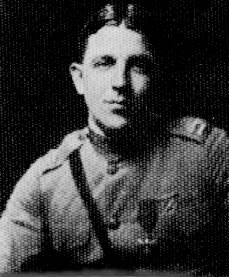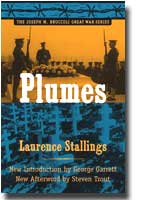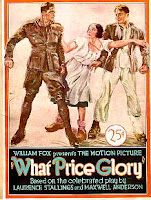
- Born 1894 in Georgia
- Graduated Wake Forest College
- WWI Veteran
- Married Helen Purefoy Poteat 1919
- Author and Playwright
- Died 1968 in California

|
|
"To every man upon this earth |

|
Laurence Tucker Stallings was born November 25, 1894, in Macon, Georgia. Macon is in Bibb County about eighty-five miles southeast of Atlanta and is considered part of the deep South. His parents were Larkin Tucker Stallings (born Nov 1861) and Aurora Brooks (born November 1865). His father was a bank teller in Macon and later a corporate treasurer in Atlanta, his mother a housemaker who introduced Laurence to the world of literature. Laurence had two siblings, both older: George Brooks Stallings (born March 1890); and Ruth Stallings (born December 1892). His paternal grandfather was the Reverend Jesse Stallings of Stallings, South Carolina.
Laurence graduated from Gresham High School (Macon, Georgia) in 1911, worked for the Royal Insurance Company of Atlanta, then set out in the fall of 1912 for Wake Forest College in North Carolina, where financial aid was provided by a Baptist minister friend of Larkin Stallings, Reverend John E. White. Wake Forest is a Baptist institution. At Wake Forest Stallings became editor of the campus literary magazine Old Gold & Black. In 1915 Laurence Stallings went to Atlanta as a reporter for the Journal, but returned to Wake Forest College in 1916 to graduate. After World War I he earned an MS degree from Georgetown University.
On March 8, 1919, Laurence Tucker Stallings, married Helen Purefoy Poteat, the daughter of Dr. William Louis Poteat. The Stallings had two daughters: Sylvia Stallings (born 1926); and Diana Poteat Stallings (born 1931).
Laurence Stallings's father-in-law,Dr. William Louis Poteat, was born in Caswell County, North Carolina, October 20, 1856. He was President of Wake Forest College from 1905 until 1927. The college then was located near Raleigh, North Carolina (not in Winston-Salem, North Carolina, as Wake Forest University is today).
Laurence Stallings was a student at Wake Forest while William Louis Poteat was president of the college. This probably is why and where he met the woman he would marry, Helen Purefoy Poteat. Helen Poteat was closely identified with her famous father and Wake Forest College, having actually been born in Wake Forest, North Carolina, April 6, 1896, when Dr. Poteat was a full professor of biology. She was a campus fixture.
Stallings came from a "militaristic" community in Georgia, that remembered well the Civil War and honored its military heroes. His southern family was known for its many Baptist preachers and Confederate soldiers. During the 1915-1916 period, he served with his father's old unit of the Georgia National Guard. However, on May 29, 1917, he joined the United States Marine Reserve. Stallings was assigned to active duty July 25, 1917, accepted a second lieutenant's commission in the regular Marine Corps, and sailed with the Second Division, arriving in France in time to participate in the fighting at Chateau-Thierry in June 1918.
There, on 26 June 1918, toward the end of the Battle at Belleau Wood, he was wounded in the leg. While leading an assault on a machine gun installation his right knee cap was blown off. Stallings nevertheless delivered his grenade, thereby eliminating the enemy position. For his action in World War I, Laurence Stallings was promoted to Captain, awarded the Silver Star by the United States Government, and given the Croix de Guerre by the French Government. Officially, the Battle at Belleau Wood raged from June 6 until July 1, killing 1800 United States soldiers and wounding 7000 (including, in addition to Stallings, authors Thomas Boyd and William Marsh.
After the war Stallings had a "bad fall on ice," further injuring the damaged leg, which was amputated in 1922. While recuperating at Walter Reed Hospital he began the novel Plumes. He used an artificial leg and many years later had to have the remaining leg amputated, thus ending his life as a double-amputee.After the war Stallings was employed as a reporter, critic, and entertainment editor at the New York World newspaper. He spent most of his time away from the newspaper continuing his work on Plumes, which turned out to be his only novel. This autobiographical work was published in 1924 and almost won the Pulitzer Prize for fiction.
Being so well-received (requiring nine reprintings in 1924 alone), Plumes served as the inspiration for The Big Parade, a very successful 1925 silent motion picture directed by King Vidor for Metro-Goldwyn-Mayer, which recently had been formed. It was the first of many war films that proved popular at the box office and was MGM's largest grossing film until Gone With the Wind in 1939. The Big Parade brought in $18 million to $22 million, depending upon the the source of the figures.
The 1925 negative of The Big Parade, originally thought destroyed in the 1960 MGM vault fire, was rediscovered by visiting film scholar Kevin Brownlow at the George Eastman House in Rochester, New York. Using modern technology, Richard May of Warner Brothers Entertainment restored the 80-year-old negative, even bringing back the original color tint. The refurbished print was screened March 18, 2005, at the Motion Picture Academy's Samuel Goldwyn Theatre, with its original score performed by the 19-piece Robert Israel Orchestra. Today, Plumes is not well-known. One reason must be the refusal by Stallings to allow further publication after 1925. However, the University of South Carolina Press republished Plumes in 2006, along with two other World War I works.
 While his accomplishments are numerous and cover five decades, Stallings probably is best remembered for his collaboration with Maxwell Anderson on What Price Glory?
While his accomplishments are numerous and cover five decades, Stallings probably is best remembered for his collaboration with Maxwell Anderson on What Price Glory?
Anderson had penned his first play, White Dessert, in 1923. The play lasted only twelve performances, but won the attention of Stallings, then a reviewer for the New York World newspaper. This resulted in Stallings and Anderson teaming on What Price Glory? The play, produced by Anthony Hopkins, opened at the Plymouth Theatre in New York City in 1924. While controversial, Glory (as the two playwrights called the work) was very successful (running for 433 performances) and critically acclaimed. Critics called it "a milestone in the development of the modern theatre toward pure naturalism in dialogue." Subsequently, two movies were based on the play. The monetary rewards from Glory allowed Anderson to retire from journalism and devote all of his energies to play writing. Stallings was able to "retire" to North Carolina.
Feed ‘em up and give ‘em hell.
Teach ‘em where they are.
Make ‘em so mad they’ll eat steel rather than get dressing from you.
Make ‘em hard but don’t break ‘em.
Laurence Stallings, What Price Glory?
Here are the observations of a writer for Time magazine September 1, 1924:
Mr. Stallings is a critic of no mean power. When you first meet him you gain an impression of bulk, and of a winning smile. He is a Southerner with a soft Southern voice, and he has many of the ingratiating qualities which are often associated with gentlemen of the lower part of the U. S. His attitude of mind is eager, even penetrating. So alert a mentality is apt to be a trifle impatient of the slowness of others' minds. Mr. Stallings is not characterized by literary or intellectual patience, although, as a man, I imagine, he has unusual understanding and tolerance of other folk and an immense amount of personal bravery.
By 1926 Stallings "retired' with his wife Helen to Forest Home, the Poteat ancestral home place near Yanceyville, North Carolina, that had been given to them by Helen's father. This magnificent country estate had been a working plantation before the Civil War, and is believed eventually to have become the property of the two daughters of Laurence and Helen Stallings. It was at Forest Home that Laurence Stallings accumulated his impressive library, including the complete work of his favorite authors: Shakespeare, George Bernard Shaw, Balzac, and Joseph Conrad. Both daughters were born during this period, but the couple must have retained a New York apartment because birth records show the girls as being born in New York. Stallings became restless with the bucolic atmosphere of Caswell County and spent more and more time in New York. In 1930 the family was living in Beverly Hills, California. And, in 1933 the address given was Santa Monica, California.
Laurence Stallings also served in World War II, although not in a combat capacity due to his age and physical limitations. He served from 2 April 1942 to 28 June 1943, with the rank of Lieutenant Colonel. His assignment in World War II was as chief of the Interview Section, U. S. Marine Corps, on the staff of General Henry Harley ("Hap") Arnold. He also served as an editor of Fox Movietone News for many years. After this war he returned to California, living in Whittier.
Stallings at one time was under contract to MGM Studios. He remained associated with the movie industry until 1954. He authored or co-authored several John Ford films, including Three Godfathers (1948), She Wore a Yellow Ribbon (1949), and The Sun Shines Bright (1954).
In 1963, Stallings published The Doughboys: The Story of the AEF, 1917-1918, a non-fiction account of World War I. Earlier, in 1933, he had published The First World War: A Photographic History. Because the photographic history depicted the horrors of war Stallings was asked if he was anti-war. While of course he was, his stock response became "that he was anti-death." Note that in 1933 he referred to World War I as the "First World War." He obviously did not believe the war in which he fought would be the last "world" conflict. Tradition has it that many of the captions to the photographs in this work were authored by Helen Poteat Stallings.
Harlan Hatcher, author of Creating the Modern American Novel (1935) made the following observation:
Taking his work in all forms as a single whole, Laurence Stallings has done more than any one American author to cut away the romantic glamour of war and to expose its wretchedness.
Asked in an interview in his later years why he had written only one novel, Stallings responded: “Like a lot of writers, I had just one thing to say and I said it.” However, while Plumes was his only novel, Stallings continued to write until his death. He purportedly was working on a novel when he died.
Married for almost seventeen years (but estranged toward the end), Laurence and Helen divorced (December 1936), and both remarried.
Stallings began a second life by marrying Louise St. Leger Vance on 19 March 1937. She had been his secretary at Fox Studios. In so doing, Stallings gave up his extensive library and home in North Carolina. Laurence and Louise had two children: Laurence Tucker Stallings, Jr (born 1939); and Sally Stallings (born 1941). After marrying Louise he signed a new contract with MGM, moved to Santa Barbara, California, and never returned to the South.
The following is from Dictionary of North Carolina Biography, William S. Powell, Editor (Volume 5 P-S) (1994) at 421 (article by Rema Williams Glover), upon which part of this biography is based:
On June 24, 1964 Stallings was honored for his service to his country by the presentation of a silver plaque and other mementos brought to his home by Major General Raymond Kier, fleet marine commander, with a full complement of officers and men forming an honor guard.
Laurence Tucker Stallings died of a heart attack, following a short illness, on February 28, 1968, in Pacific Palisades, California. He was buried March 8, 1968, with full military honors at Fort Rosecrans National Cemetery in Point Loma, California (near San Diego). He had been a successful journalist, author, literary critic, playwright, and screenwriter. His portrait hangs in the Gerald White Johnson Room at Wake Forest University, a room dedicated to Wake Forest University writers. Many who are familiar with his work and obvious talent are surprised at how obscure Stallings remains today. He rarely even makes a list of "minor" twentieth-century American authors.
After her divorce from Laurence Stallings, Helen Purefoy Poteat married Gordon Preston Marshall in 1944. At some point after her second marriage Helen Poteat Marshall returned to Forest Home in Caswell County, North Carolina. The house, while sound, had fallen into some disrepair. She completely restored it, and is believed to have added one or more rooms. The two Stallings daughters lived at Forest Home at times during the 1950's.
It was in Southern Pines, North Carolina, that Helen Poteat Stallings Marshall died on her birthday, April 6, 1980. She was 84. Laurence Stallings, her first husband, had been dead for twelve years.